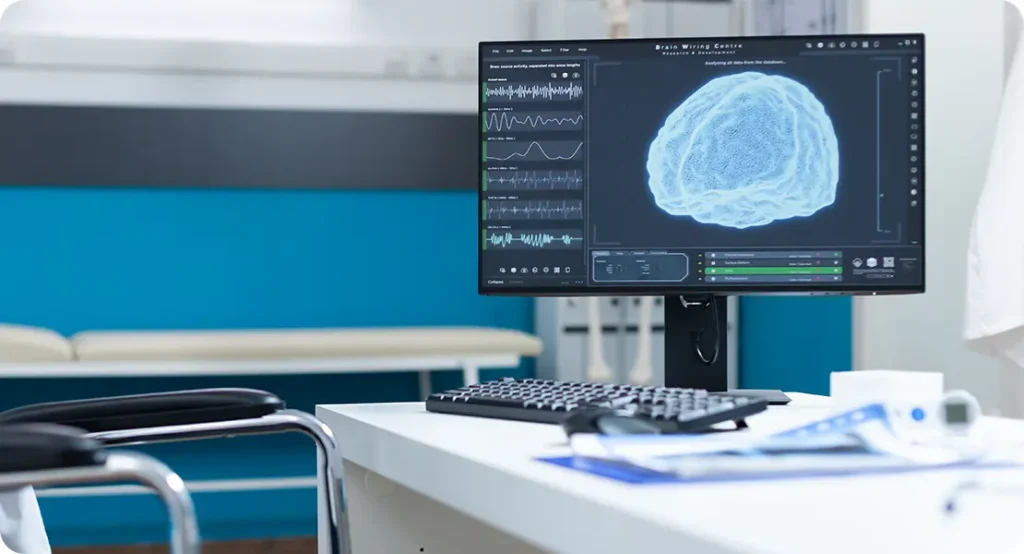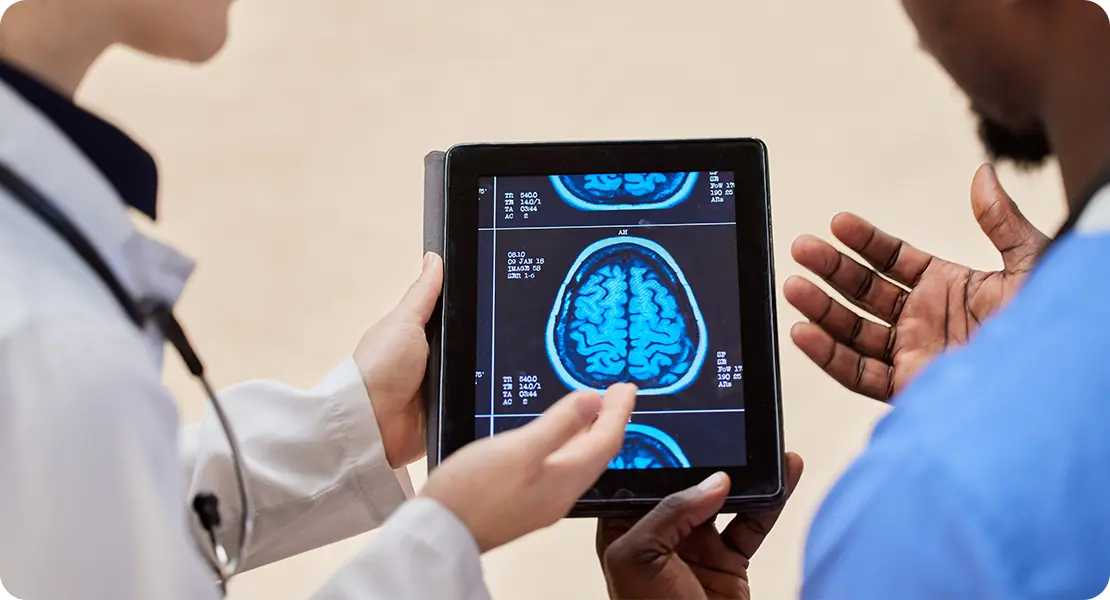When you think of cataract surgery, you probably imagine a simple lens replacement removing a cloudy lens and inserting a clear, artificial one. But what’s often overlooked is how much your brain has to adjust afterward.
Your eyes don’t work in isolation. They’re part of a sophisticated visual system, where the brain constantly interprets, filters, and makes sense of what you see. So when your eyes suddenly start sending new, sharper, and differently coloured information after surgery, the brain needs time to adapt.
This process is called neuroadaptation and it’s a fascinating example of how flexible and intelligent the human brain really is.
In this article, we’ll explain how neuroadaptation works after cataract surgery, why some people adjust faster than others, and what you can do to help your visual system adapt more smoothly.
Understanding the Connection Between the Eye and Brain
The eye is often described as a camera but that’s only half the story. Your brain is the processor that interprets everything the camera captures.
The retina at the back of your eye converts light into electrical signals, which travel along the optic nerve to the visual cortex. From there, the brain builds the images you see combining information from both eyes, correcting colour balance, judging depth, and aligning movement.
When cataracts cloud your natural lens, that communication changes. The brain gradually adapts to the blurred input sometimes for years and learns to function with less detail and reduced colour accuracy. Then, after surgery, the brain suddenly receives clear, bright, and high-contrast visual data again. It’s a huge shift, and your visual processing system needs time to recalibrate.
What Is Neuroadaptation?

Neuroadaptation refers to the brain’s ability to reorganise itself when visual input changes. It’s a form of neuroplasticity, meaning your brain can form new neural pathways and connections to process new types of sensory information.
After cataract surgery, the light entering your eyes is dramatically different from what your brain was used to. Colours appear more vivid, edges sharper, and brightness levels higher. The brain must learn to interpret this new input a process that can take anywhere from a few days to several weeks. You can think of it as your brain “retraining” itself to see again.
Why Vision Feels “Different” After Surgery
It’s completely normal for your vision to feel strange, even if your surgery was technically perfect. Patients often describe:
- Brighter, bluer colours because cataracts cause a yellowish tint that fades once removed.
- Slight distortion or depth confusion especially if only one eye has been operated on.
- Unusual perception of distance as your brain adjusts to changes in focus and magnification.
- Temporary imbalance if your new lens (IOL) affects how each eye sends information.
All of these sensations are signs that your brain is actively recalibrating.
The Role of Intraocular Lenses (IOLs)

The type of intraocular lens implanted during cataract surgery significantly affects how your brain adapts.
1. Monofocal IOLs
These lenses provide clear vision at one focal distance usually for distance or near tasks. Neuroadaptation here is relatively quick because the brain only needs to adjust to clarity, not focus differences.
2. Multifocal or Trifocal IOLs
These lenses provide vision at multiple distances by splitting light into different focal points. While they offer freedom from glasses, they require more neuroadaptation. The brain must learn to switch seamlessly between focus zones and suppress visual “noise” such as halos or glare.
3. Extended Depth of Focus (EDOF) IOLs
These lenses create a continuous range of vision. Adaptation is often smoother than multifocals but still requires time for the brain to fine-tune contrast sensitivity.
4. Toric IOLs
Used for astigmatism correction, these lenses require precise alignment. The brain must adjust to sharper visual input and corrected distortion patterns.
Each IOL type introduces new optical signals and your brain’s neuroadaptation process determines how naturally they’re perceived.
The Science of Neuroplasticity and Vision
Your brain’s visual cortex remains adaptable throughout life even in older adults. Studies in visual neuroscience show that the brain can “relearn” how to interpret visual input long after vision changes occur.
This adaptability relies on neural feedback loops, where the brain compares old visual memories with new sensory information. Over time, it corrects mismatches and stabilises perception.
That’s why some people experience mild visual confusion at first, but their brain quickly adjusts within days. For others, it may take weeks of subtle fine-tuning before vision feels completely natural again.
Why Neuroadaptation Takes Time
Every person’s visual journey after cataract surgery is unique. Several factors influence how quickly you adapt:
1. Duration of Vision Loss
If you lived with cataracts for many years, your brain has become accustomed to low contrast and reduced light. It needs more time to unlearn those patterns.
2. Type of Lens Implanted
As mentioned, multifocal and EDOF lenses require more complex adaptation.
3. Binocular Balance
If one eye sees more sharply than the other (or if surgery is done on one eye first), your brain must learn to merge two slightly different images.
4. Age and Brain Plasticity
While neuroplasticity remains possible at any age, younger brains tend to adapt faster. However, even older adults can successfully retrain their visual pathways with patience.
5. Pre-existing Eye Conditions
Conditions like macular degeneration, diabetic retinopathy, or previous eye surgery can influence adaptation.
In short neuroadaptation is not a race. It’s a gradual process where your brain rewires itself for optimal vision.
Typical Timeline for Visual Adjustment
Everyone’s experience is a little different, but here’s a general idea of what you can expect after getting your lenses.
In the first few days, you might notice that colours look unusually bright or that light feels a bit harsh. Some people also feel a mild sense of visual imbalance don’t worry, that’s just your brain getting used to the clearer input and the new lens alignment.
After about one to two weeks, things usually start to settle. You’ll likely see sharper details, experience less glare, and notice better contrast overall. This happens as your brain’s visual pathways begin to stabilise.
By three to six weeks, your vision should start to feel “normal” again. Your eyes will be working together more comfortably, and you’ll stop noticing the lenses as much.
Around the two to three-month mark, most people reach their peak adaptation. By this point, your brain has fully adjusted to the new visual information, and the lenses feel completely natural.
If you’re wearing multifocal lenses, it can take a bit longer sometimes up to six months especially as your brain learns to handle multiple focal distances at once.
What You Can Do to Support Neuroadaptation
You can actively help your brain adapt after cataract surgery through simple daily habits.
1. Be Patient and Consistent
Your brain needs time to learn don’t expect perfect clarity overnight. Give yourself at least a few weeks to settle into the new visual experience.
2. Use Both Eyes Together
If both eyes have had surgery, use them simultaneously to strengthen binocular coordination. Avoid covering one eye unnecessarily.
3. Gradual Exposure to Light
Bright light may feel uncomfortable at first. Gradually increase your exposure to natural daylight to help your visual system adjust to new brightness levels.
4. Follow Your Eye Drops and Aftercare
Consistent aftercare supports healing, ensuring your optical signals are clear for the brain to interpret accurately.
5. Read, Focus, and Observe
Engage your eyes. Read books, look at fine details, or watch TV these activities stimulate the visual cortex and help the brain recalibrate.
6. Stay Calm with Visual Anomalies
Seeing halos, glare, or mild ghosting early on doesn’t mean something’s wrong. These symptoms often diminish as neuroadaptation progresses.
Visual Training and Rehabilitation
Some patients benefit from visual training exercises after cataract surgery, particularly if adapting to multifocal or toric lenses.
These exercises aim to reinforce neural connections between the eyes and brain. Common approaches include:
- Focus shifting: Alternating between near and far objects to train accommodation.
- Tracking exercises: Following moving objects to improve coordination.
- Contrast recognition: Using visual puzzles or apps to enhance contrast sensitivity.
Emerging research suggests that structured visual rehabilitation can accelerate neuroadaptation, especially in older adults.
If your adaptation feels unusually slow, your surgeon may refer you for optometric vision therapy or recommend digital vision training tools.
When to Seek Professional Advice
Most patients adapt smoothly, but contact your specialist if you experience:
- Persistent visual distortion beyond three months.
- Double vision or significant imbalance between eyes.
- Sudden changes in clarity, light flashes, or new floaters.
- Discomfort that doesn’t resolve with time.
Your ophthalmologist can ensure your intraocular lens is correctly positioned and that your eyes are healing properly. At the London Cataract Centre, specialists carefully assess each patient’s neuroadaptation journey and provide tailored support, whether through follow-up care or visual training advice.
The Role of the Surgeon and Technology
Modern cataract surgery uses advanced optical technologies designed to make neuroadaptation smoother.
- Pre-surgical imaging and biometry ensure precise lens selection and positioning.
- Customised IOLs like multifocal, toric, and EDOF lenses optimise vision for individual lifestyles.
- Laser-assisted surgery provides better predictability, improving early visual clarity and aiding faster brain adaptation.
At the London Cataract Centre, surgeons combine these technologies with personalised care to help patients achieve not just clearer vision but comfortable, natural sight through balanced neuroadaptation.
How Neuroadaptation Affects Daily Life
During your adaptation period, you might notice subtle differences in how your brain perceives daily tasks:
- Reading: Words may appear sharper but require new focus effort.
- Driving: Bright lights or glare might feel distracting at first.
- Colours: Whites seem bluer, and contrasts are stronger a normal result of restored clarity.
- Depth perception: It may take a week or two to feel confident with stairs or spatial awareness again.
With time, these sensations fade as your brain integrates the new visual input seamlessly.
Can Neuroadaptation Be Measured?
Researchers are exploring ways to measure how well the brain adapts after cataract surgery. Tools like contrast sensitivity tests, binocular vision assessments, and functional MRI scans help map changes in the visual cortex.
While these methods are mostly research-based for now, they confirm what patients already experience the brain is remarkably adaptable and continues to refine visual perception long after surgery.
Supporting Brain and Eye Health After Surgery
Good overall health supports neuroplasticity and visual function. Consider these habits to keep your visual system performing at its best:
- Eat for your eyes. Include omega-3 fatty acids, lutein, and antioxidants.
- Stay hydrated. Dehydration can affect tear film and focus comfort.
- Sleep well. The brain consolidates visual adaptation during rest.
- Exercise gently. Improves blood flow and oxygen delivery to the eyes and brain.
- Protect your eyes from UV. Always wear sunglasses outdoors.
A healthy lifestyle helps your brain and eyes continue working in harmony long after surgery.
FAQs: Neuroadaptation After Cataract Surgery
1. How long does it usually take for your brain to adjust after cataract surgery?
For most people, the brain begins adapting within the first few days after surgery. You may notice brighter colours and sharper contrast almost immediately, but your vision can still feel “different” for a while. Generally, it takes about one to two months for most of the neuroadaptation to occur, although some people reach full comfort around the three-month mark. If you’ve had multifocal or trifocal lenses implanted, the process might take longer sometimes up to six months as your brain learns to handle multiple focal points.
2. Why does my vision look strange even though my surgery went well?
It’s very common for your vision to feel unusual right after surgery, even when the procedure was completely successful. Your brain has been used to processing blurred, yellow-tinted images through your cataracts, and suddenly it’s receiving bright, high-contrast information again. This can make colours look too vivid, lights appear harsh, or distances feel slightly “off.” These sensations are part of the brain’s natural recalibration and typically improve as your neural pathways adjust to the new lens input.
3. Can neuroadaptation happen in older adults, or is it slower with age?
Age can influence the speed of neuroadaptation, but it doesn’t stop it from happening. Even in your 70s or 80s, your brain retains remarkable plasticity the ability to form new neural connections. While younger patients might adjust a bit faster, older adults can still achieve full adaptation with a little more time and consistent use of both eyes together. Patience, visual activity, and proper aftercare go a long way in helping your brain adjust, regardless of age.
4. What can I do at home to help my brain adapt more smoothly?
The best thing you can do is use your eyes regularly and give your brain consistent input. Try reading, watching television, or going for short walks to help your brain process different visual conditions. Gradually exposing yourself to daylight also helps if brightness feels uncomfortable at first. Following your aftercare routine especially using prescribed eye drops keeps your eyes healthy and ensures clear signals for the brain to interpret. Above all, be patient. Neuroadaptation is a learning process, not an instant switch.
5. Why do lights and colours seem too bright after my surgery?
Before surgery, cataracts filter out a lot of light and create a yellowish tint over everything you see. Once your cloudy lens is replaced with a clear one, the sudden increase in brightness can feel overwhelming. It’s similar to walking out of a dimly lit room into sunlight your brain and eyes simply need time to recalibrate. Over the following days and weeks, your visual system will readjust, and the brightness will start to feel natural again.
6. Does the type of lens I choose affect how quickly I adapt?
Yes, it does. If you’ve received a monofocal lens, your adaptation is usually quick because your brain only needs to adjust to the improved clarity. Multifocal, trifocal, or extended depth of focus (EDOF) lenses require more time since they introduce multiple focal distances. Your brain must learn how to switch seamlessly between them and reduce any halos or glare you might initially notice. With consistent use and time, most people find that their vision feels balanced and natural again.
7. Is it normal to feel unbalanced or dizzy after surgery?
Some people do experience mild imbalance or dizziness in the first few days. This happens because your eyes and brain are re-learning how to work together with the new optical input. If you’ve only had one eye operated on, the difference between the old and new vision can temporarily confuse your depth perception. Once both eyes are balanced, or your brain completes its adjustment, that sense of imbalance usually fades. However, if dizziness continues for more than a few weeks, it’s a good idea to check in with your surgeon.
8. Can visual training exercises really speed up neuroadaptation?
Yes, visual training can make a difference, especially for people adapting to multifocal or toric lenses. These exercises are designed to stimulate the brain’s visual centres and improve coordination between your eyes. Activities such as shifting focus between near and distant objects, or following moving targets, encourage your brain to fine-tune its processing. Some clinics and optometrists even offer structured visual rehabilitation programs or digital training apps that can support faster adaptation.
9. When should I worry that my vision isn’t adapting properly?
If your vision still feels distorted or uncomfortable after three months, it’s worth getting checked by your ophthalmologist. While mild fluctuations are normal, persistent imbalance, double vision, or sudden changes in clarity shouldn’t be ignored. In most cases, slow adaptation simply means your brain needs more time. But your surgeon can confirm that your intraocular lens is correctly positioned and rule out any other issues that might be affecting your recovery.
10. Will neuroadaptation continue even after I feel fully adjusted?
Yes, and that’s one of the fascinating things about the human brain. Even after your vision feels perfectly natural, your brain continues to make subtle refinements to improve clarity, colour balance, and comfort. This ongoing fine-tuning is part of long-term neuroplasticity, and it ensures your vision remains stable over time. Think of it as your brain and eyes continuing to “sync” with each other to give you the clearest, most comfortable view of the world possible.
Final Thought: Adapting to a Clearer World
Adjusting to your new vision after cataract surgery is a fascinating journey between your eyes and your brain. Neuroadaptation may take time, but it’s proof of just how adaptable and intelligent your visual system really is. With patience, consistency, and proper aftercare, most people find their new, sharper vision feels completely natural within a few weeks to months.
If you’re unsure about your vision or simply want expert guidance, our team at London Cataract Centre is here to help. We specialise in safe, effective cataract surgery with advanced lens options designed to restore clear sight and get you back to enjoying everyday activities including driving with confidence.
References:
1. Zhang, L., Zhang, J., Zhu, H. et al. (2021) ‘Comparison of visual neuroadaptations after multifocal and monofocal intraocular lens implantation’, Frontiers in Neuroscience, 15, p. 648863. https://pmc.ncbi.nlm.nih.gov/articles/PMC8236945/
2. Leyland, M. and Zinicola, E. (2003) ‘Multifocal versus monofocal intraocular lenses in cataract surgery: a systematic review’, Journal of Cataract & Refractive Surgery, 29(12), pp. 2383-2390. https://pubmed.ncbi.nlm.nih.gov/13129879/
3. Piñero, D.P., et al. (2023) ‘Randomised placebo-controlled clinical trial evaluating neuroadaptation in patients after intraocular lens implantation’, International Ophthalmology, https://link.springer.com/article/10.1007/s10792-023-02809-9
4. Rosa, A.M., Miranda, Â.C., Patrício, M., McAlinden, C., Silva, F.L., Murta, J.N. and Castelo‐Branco, M. (2017) ‘Functional magnetic resonance imaging to assess neuroadaptation to multifocal intraocular lenses’, Journal of Cataract & Refractive Surgery, 43(10), pp. 1287-1296. https://www.sciencedirect.com/science/article/pii/S0886335017306417
5. Zhou, S., Figueiredo, A. G. d. A., Abulimiti, A., Hida, W. T. & Chen, X. (2023) ‘Evaluation of Life Quality of Patients Submitted to Cataract Surgery with Implantation of Trifocal Intraocular Lenses’, Journal of Personalized Medicine, https://www.mdpi.com/2075-4426/13/3/451

